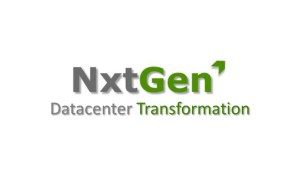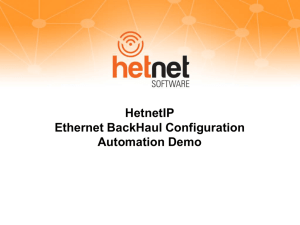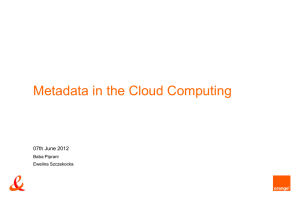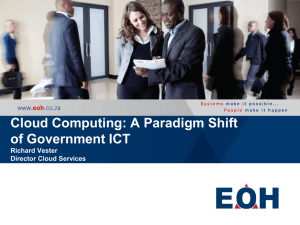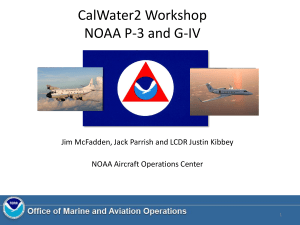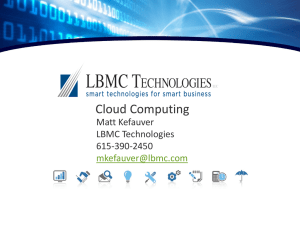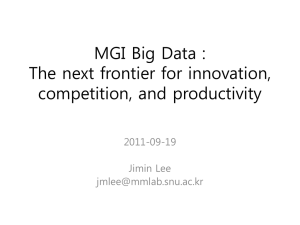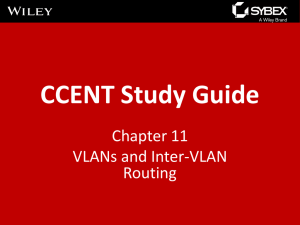VMware presentation - ISACA Denver Chapter
advertisement
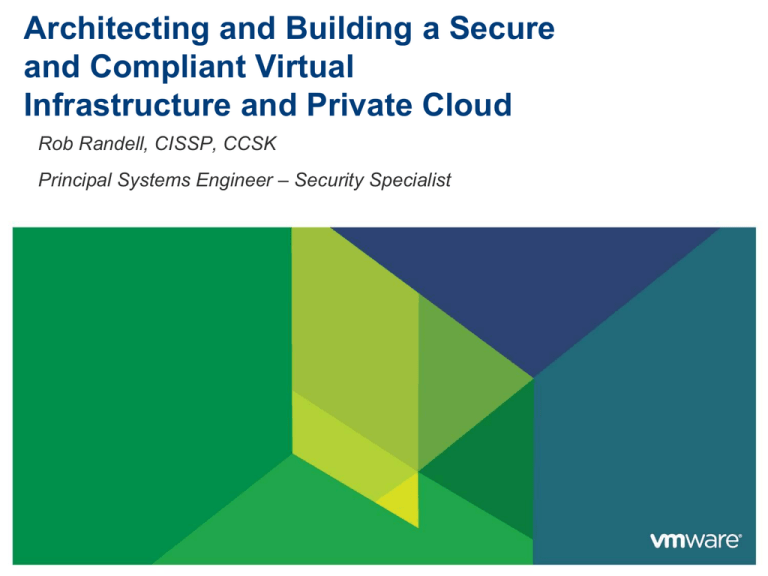
Architecting and Building a Secure and Compliant Virtual Infrastructure and Private Cloud Rob Randell, CISSP, CCSK Principal Systems Engineer – Security Specialist Agenda • Security Perspective on Customer Journey to the Cloud • Whiteboard Overview of How Virtualization and Cloud Affect Datacenter Security • How to Secure our Cloud and Make it Compliant • Network Security and Secure Multi-tenancy in the Cloud Security Perspective On Customer Deployment Architectures 0 PHYSICAL 1 AIR GAPPED PODS 2 MIXED TRUST CLUSTERS 3 ON-PREMISE PRIVATE CLOUD 4 DEDICATED PRIVATE “CLOUD” (eBay, CSC) 5 PUBLIC MULTI-TENANT CLOUD (Terremark, EC2) 0 Physical deployments are still considered to be most secure and remain in all enterprises 1 Air gapped pods are preferred by security teams for virtualized high risk assets (SOX, PCI, DMZ) 2 Mixed trust clusters typically have the M&M security model, blocking important asset migration to them 3 Private cloud is an extension of the mixed trust deployment, with more automation and self service 4 Dedicated Private Cloud SLAs make it virtually the same risk level as the on-premise deployments 5 Multi-tenant Public Cloud is just emerging, with concerns around visibility, audit, control and compliance The Datacenter needs to be secured at different levels Perimeter Security • Sprawl: hardware, FW rules, VLANs Perimeter security device (s) at the edge • •Rigid FW rules Firewall, VPN, Intrusion Prevention • •Performance bottlenecks • Load balancers Cost & Complexity Keep Atthe bad guys out the vDC Edge Internal Security VLAN 1 VLANs • VLAN or subnet based policies • Interior or Web application Firewalls • DLP, application identity aware policies Segmentation of applications, servers End Point Security • Desktop AV agents, • Host based intrusion • DLP agents for privacy 4 End Point Protection Simple Definition of a Virtual Datacenter • The isolated and secured share of a virtualized multitenant environment. • Like a physical datacenter shares the Internet for interconnectivity, the tenants of a cloud (public or private) share the local network within the private datacenter or in the service providers network, and also like a physical datacenter, each tenant also has their own private, isolated, and secured virtual networking infrastructure. Tenant 1 DMZ 5 App1 Tenant … Tenant 2 App2 DMZ App1 App2 DMZ App1 App2 Securing virtual Data Centers (vDC) with legacy security solutions PERIMETER SECURITY INTERNAL SECURITY WEB ZONE APPLICATION ZONE ENDPOINT SECURITY DATABASE ZONE Internet vSphere vSphere vSphere VIRTUALIZED DMZ WITH FIREWALLS • Air Gapped Pods with dedicated physical hardware • Mixed trust clusters without internal security segmentation • Configuration Complexity o VLAN sprawl o Firewall rules sprawl o Rigid network IP rules without resource context • Private clouds (?) Legacy security solutions do not allow the realization of true virtualization and cloud benefits 6 Platform Sec. Secure the Underlying Platform FIRST Use the Principles of Information Security • Hardening and Lockdown • Defense in Depth • Authorization, Authentication, and Accounting to enforce Separation of Duties and Least Privileges • Administrative Controls For virtualization this means: • Harden the Virtualization layer • Setup Access Controls • Secure the Guests • Leverage Virtualization Specific Administrative Controls What Auditors Want to See: • Network Controls • Change Control and Configuration Management • Access Controls & Management • Vulnerability Management VMkernel vnic vnic vnic Protection of Management Interfaces is Key Mgmt Production Storage vSwitch2 vSwitch1 vmnic1 2 Prod Network 3 4 Mgmt Network vCenter Segment out all non-production networks • Use VLAN tagging, or • Use separate vSwitch (see diagram) Strictly control access to management network, e.g. • RDP to jump box, or • VPN through firewall VMware vSphere 4 Hardening Guidelines http://www.vmware.com/resources/techresources/10109 Other ESX/ESXi hosts IP-based Storage 9 Separation of Duties Must Be Enforced More Power Super Cloud Admin Cloud Networking Admin Less Power Cloud Server Admin Tenant A Admin VM Admin Cloud Storage Admin Tenant B Admin VM Admin VM Admin Tenant C Admin VM Admin VM Admin VM Admin Air Gapped Design – Costly and Inefficient Internet Remote Access Aggregation Access vSphere VPN Gateway VPN Gateway VPN Gateway L2-L3 Switch L2-L3 Switch L2-L3 Switch Firewall Firewall Firewall Load Balancer Load Balancer Load Balancer Switch Switch Switch vSphere Company X 11 vSphere vSphere Company Y vSphere vSphere Company Z Multi-tenancy – Physical Firewall and VLAN Internet AccessAggregation VLAN1000 VLAN 1001 VLAN 1002 L2-L3 Switch Firewalls VLAN 1002 VLAN 1001 VLAN 1000 Legend : PG-X VLAN 1000 VLAN 1001 Port group Company X n/w PG-Y Port group Company Y n/w PG-Z Port group Company Z n/w VLAN 1002 Port group to VM Links vDS/vSS PG-X (vlan1000) PG-Y (vlan 1001) PG-Z (vlan 1002) VMware vSphere + vShield Company X 12 Company Y Company Z Virtual to Ext. Switch Links Multi-tenancy Virtualization Aware Internet AccessAggregation L2-L3 Switch Infrastructure VLAN (VLAN 1000) Legend : Provider VLAN (VLAN 100) VLAN1000 VLAN1000 VLAN1000 PG-X Port group Company X n/w PG-Y Port group Company Y n/w PG-Z Port group Company Z n/w PG-C External uplink Port group Internal Company Links External Up Link vDS vDS to Ext. Switch Links PG-X(vlan1000) PG-C(vlan100) PG-Y(vlan1000) PG-Z(vlan1000) vShield Edge VM VMware vSphere + vShield Traffic flow not allowed Company X 13 Company Y Company Z Enforce Microsegmentation Inside the vDC Protect applications against Network Based Threats • Application-Aware Full Stateful Packet Inspection FW Virtual Datacenter 1 Web App • Control on per-VM/per vNIC level • See VM-VM traffic within the Virtual Datacenter 2 same host • Security groups enforced with Database DISA & PCI CIS & PCI VM movement VMware vSphere + vCenter ESX Hardening Cluster B 14 Cluster A Offload Endpoint Based Security Functions with VM Introspection Techniques Improves performance and effectiveness of existing endpoint security solutions • Offload Functions • AV • File Integrity Monitoring • Application Whitelisting 15 Virtualized Security and Edge Services Cloud Aware Security Elastic Logical Efficient Automated Programmable Security as a Service Edge/Perimeter Protection • Secure the edge of the virtual datacenter • Security and Edge networking services gateway Internal Security and Compliance • Micro-segmentation • Discover and report regulated data in the Datacenter and Cloud Endpoint Security • Efficient offload of endpoint based security into the cloud infrastructure – i.e.- anti-virus and file integrity monitoring 16 Continuous and Automated Compliance Ongoing Change and Compliance Management Understand Pervasive Change Capture in-band and out-of-band changes Are you still Compliant? Deployed from Gold Standard Planned Change • Remediate Compliant State • Exceptions Unplanned Change Fit within current enterprise change mgmt Noncompliant State workflow process Protect against vulnerabilities Hypervisor-based anti-virus provides superior protection Remediate (RFC Optional) Patch Management guards against known attacks Software provisioning tied to compliance Day to day vulnerability checks 17 Compliant State Mark as Exception Conclusion • The Cloud Had Great Benefits and like any Technology its Associated Risks • These Risks Can Be Mitigated With Proper Controls • The Classic Principles of Information Security Should be Applied • Key Architecture Decisions must be made for Security • Tools Designed for the Cloud Must Be Utilized 18 Confidential Questions? Rob Randell, CISSP, CCSK Principal Security and Compliance Specialist


